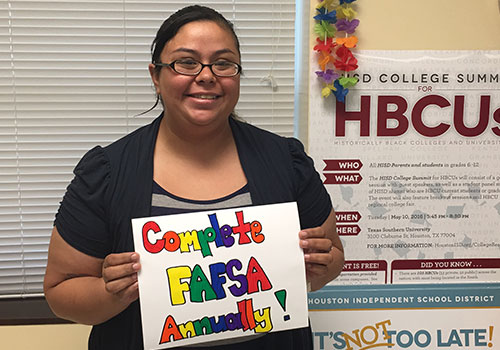News and Updates About Federal Financial Aid & the FAFSA: Students | Practitioners
Blogs
How to Support Students Through the New FAFSA Timeline
February 7, 2024
By Anika Van Eaton, Brendan Williams

The new FAFSA will be easier for students and families to complete and, according to the Department of Education, will unlock Pell Grant eligibility for 610,000 new students. However, this first year of implementation brings challenges, and we’re sharing our recommendations for supporting students and families.
The U.S. Department of Education Federal Student Aid Office (FSA) announced that the simplified FAFSA will open by December 31, meeting the legally required deadline of January 1, 2024. With many technology systems to update and an underresourced Department of Education, FAFSA is opening three months later than the traditional October 1, drastically shortening the time for students to complete the FAFSA and colleges to package financial aid.
FSA’s FAFSA Road Map provides some clarity on the rollout. When students complete the online FAFSA, they will receive a confirmation page with their estimated Student Aid Index (the new term for Expected Family Contribution), Federal Pell Grant Eligibility, and an email about the next steps. However, colleges will not begin to receive students’ FAFSA data, called the Institutional Student Information Records, until early March. Students will not receive their FAFSA submission summary until FSA completes database matches and verification selection, which is expected to occur in early March as well. Colleges will also have internal processes to complete before they send students’ financial aid offers. FSA will begin processing paper FAFSA after pocessing the intial batch of online FAFSAs.
Now, let’s explore what we can do to support students and families as they navigate this new financial aid process.
Students won’t be able to correct or update their FAFSA until early March, so reviewing for errors before submission is critical. Make sure students and families know they can return to their FAFSA in March to review it and make any necessary edits.
We encourage you to leverage uAspire’s resources and financial aid webinars as you support students and families this year. We’re here to help.
The U.S. Department of Education Federal Student Aid Office (FSA) announced that the simplified FAFSA will open by December 31, meeting the legally required deadline of January 1, 2024. With many technology systems to update and an underresourced Department of Education, FAFSA is opening three months later than the traditional October 1, drastically shortening the time for students to complete the FAFSA and colleges to package financial aid.
FSA’s FAFSA Road Map provides some clarity on the rollout. When students complete the online FAFSA, they will receive a confirmation page with their estimated Student Aid Index (the new term for Expected Family Contribution), Federal Pell Grant Eligibility, and an email about the next steps. However, colleges will not begin to receive students’ FAFSA data, called the Institutional Student Information Records, until early March. Students will not receive their FAFSA submission summary until FSA completes database matches and verification selection, which is expected to occur in early March as well. Colleges will also have internal processes to complete before they send students’ financial aid offers. FSA will begin processing paper FAFSA after pocessing the intial batch of online FAFSAs.
Now, let’s explore what we can do to support students and families as they navigate this new financial aid process.
Complete the FAFSA.
The FAFSA is open, and we should provide students and families with clear guidance that the FAFSA should be completed now. Even with the current technical issues and delays in processing, helping families start and submit the FAFSA will help get them on the right track for when the FAFSA processes in March. If families experience technical issues, encourage them to keep trying and to contact the FSA help center for support. Many states moved their priority deadlines later to give students more time to submit their FAFSA to be eligible for state financial aid. Check with your state agency to identify your state’s priority FAFSA deadline.
Encourage FAFSA review for accuracy before submitting.
Students won’t be able to correct or update their FAFSA until early March, so reviewing for errors before submission is critical. Make sure students and families know they can return to their FAFSA in March to review it and make any necessary edits.Prepare for appeals.
Families who have experienced changes in their finances from 2022 or have other reasons to appeal may experience an abbreviated timeline due to the delays in colleges receiving FAFSA information. Share resources like Swiftstudent and encourage students to contact their colleges to discuss why they are appealing.Promote financial aid offer review.
Since colleges won’t start to receive FAFSA data until early March, we expect financial aid offers to begin arriving late spring. This delay leaves less time to consider financial aid offers to make informed financial decisions about college. Explain to students that financial aid offer review is a critical step to take before deciding on a college and to use uAspire’s College Cost Calculator to quickly decipher and compare their financial aid offers from different colleges.We encourage you to leverage uAspire’s resources and financial aid webinars as you support students and families this year. We’re here to help.